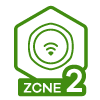NWA1123ACv3 disconnecting users to often
Options
WvandeHoef
Posts: 22  Freshman Member
Freshman Member


 Freshman Member
Freshman Member

In order to improve the 5G wifi coverage in the house I wanted to add another WAP to the existing 4x NWA1123-AC v2, but as the V2 has been EOL I got a v3.
As I wanted to explore the Mesh networking I moved all AP from local to Nebula managed and mounted the V3 in an area where I could not get a decent 5G connection, but 4 meters line of sight form 2 V2 WAP's, where it should have -65dBm signal (as measured by my mobile phone.
The Mesh was created on both the 2.4G and 5G network and the V3 became operational and after checking the RSSI I decreased the power levels to 19dBM for 5GHz and 15dBm for 2.4GHz and still had a good connection from Tablets and phones.
Strange enough the 2.4GHz Tuya devices that I wanted to connect trough the nearby (3m LOS) V3 initially connected to that BSSID, but after an hour the reconnected to a V2 that was both further away and had a -20dBm worse signal. Rebooting that other WAP brought them back to the V3, but after an hour they again moved away to a V2 with a worse signal.
As I believed this could be the Mesh network being slower, I added a direct POE cable to the V3 and shutdown the mesh, making all nodes individual WAP with a direct 1GBE link to the switch. The strange and unwanted behavior unfortunately did not go away.
This weekend I exchanged the location of the V3 with the V2 in the living room, but the family is not happy about this as frequently their movies get interrupted. In the log I see the V3 kick them out and they need to reconnect with one of the other V2's, again with at least -20dBm worse signal and further away.
I have now disabled the smart steering in Nebula and this seems to solve it, but the smart steering was used to keep distant devices out of the network. Minimum level to connect was set to -70dBm and disconnect at -73dBm, as the coverage in the whole house is between -45dBm/-65dBm.
When smart steering is enabled the V3 is kicking out devices that are 3m away with no walls or furniture in between and RSSI on the device in the -60dBm. The log in Nebula is showing a way lower dBm for that device though.
Questions:
- What is the main difference between V2 and V3 and could that explain what we see? - Has the V3 a power saving option that changes the receiving amplifier after some time, what could explain why the V3 thinks the device is having a different RSSI as the device is showing?
- Could the unit itself have an issue?
In case you want to check the Nebula log, the serial for this device is about and the Nebula account is under my email address.
Kind regards,
Wouter
As I wanted to explore the Mesh networking I moved all AP from local to Nebula managed and mounted the V3 in an area where I could not get a decent 5G connection, but 4 meters line of sight form 2 V2 WAP's, where it should have -65dBm signal (as measured by my mobile phone.
The Mesh was created on both the 2.4G and 5G network and the V3 became operational and after checking the RSSI I decreased the power levels to 19dBM for 5GHz and 15dBm for 2.4GHz and still had a good connection from Tablets and phones.
Strange enough the 2.4GHz Tuya devices that I wanted to connect trough the nearby (3m LOS) V3 initially connected to that BSSID, but after an hour the reconnected to a V2 that was both further away and had a -20dBm worse signal. Rebooting that other WAP brought them back to the V3, but after an hour they again moved away to a V2 with a worse signal.
As I believed this could be the Mesh network being slower, I added a direct POE cable to the V3 and shutdown the mesh, making all nodes individual WAP with a direct 1GBE link to the switch. The strange and unwanted behavior unfortunately did not go away.
This weekend I exchanged the location of the V3 with the V2 in the living room, but the family is not happy about this as frequently their movies get interrupted. In the log I see the V3 kick them out and they need to reconnect with one of the other V2's, again with at least -20dBm worse signal and further away.
I have now disabled the smart steering in Nebula and this seems to solve it, but the smart steering was used to keep distant devices out of the network. Minimum level to connect was set to -70dBm and disconnect at -73dBm, as the coverage in the whole house is between -45dBm/-65dBm.
When smart steering is enabled the V3 is kicking out devices that are 3m away with no walls or furniture in between and RSSI on the device in the -60dBm. The log in Nebula is showing a way lower dBm for that device though.
Questions:
- What is the main difference between V2 and V3 and could that explain what we see? - Has the V3 a power saving option that changes the receiving amplifier after some time, what could explain why the V3 thinks the device is having a different RSSI as the device is showing?
- Could the unit itself have an issue?
In case you want to check the Nebula log, the serial for this device is about and the Nebula account is under my email address.
Kind regards,
Wouter
0
Accepted Solution
-
Update the follow up of this post:
Through the site survey, WvandeHoef tried several placement spots of the AP in the room. Such as:
1. Placing AP on the side of the room, and facing front panel up
2. Placing AP on the side wall of the room , and facing towards the other side
3. Placing the AP on the middle ceiling of the room, facing front panel down
As the result, the AP deployed in way No.3 provides the best performance to all wireless devices in the same room, now all the devices connects to it with -4X dBm signal strength.
I think it could be caused by the radio pattern/signal path of AP and client devices:
In customer's house there's another AP deployed in the 1st Floor (right above the testing room in ground floor). In the previous test, the device "Logitech Hub" placed in the ground floor is facing up and directly connect to the 1st Floor AP, (with -62~-68 dBm signal strength), but not the AP placed in the same room with (-62 ~ -67 dBm) signal strength.
The device is using 2.4GHz radio signal which has higher penetration capability, so the signal coming from the 1st floor is as strong as the one from AP in the same room. Besides, the Logitech Hub is facing up towards the 1st floor, comparing to the signal coming from the nearby AP (placed in the other side of the room) might facing several reflections, the client therefore choose to connect to the 1st floor AP under the same signal strength condition.
Now since the AP is deployed on the ceiling of Ground Floor, which can provide the line-of-sight signal in each other's directly received coverage, so the wireless client can connect to the correct AP.
Best Regards,
Richard
0
All Replies
-
Hi @WvandeHoef
1. Could you please enable the "Zyxel Support" and provide us the org/site information of your NCC? This way we can check the log and investigate in the case happened in your environment.
(press the "save" after you enable the zyxel support)
2. There is no power saving mechanism on both models, since they only require 802.3af power, this means AP fully utilize its antennas and power to transmit the data.
3. Could you please share with us about how you verify the signal in your environment and get the -20 dBm value? Also, what's the exact received power on the station side?
4. Please also share the MAC of issuing device with us, as well as the time point when the issue occurs. This way we can track the related logs when we check logs in your site.
Best Regards,
Richard
0 -
Hi Richard,
Support is enabled.
Details on Org, Site and AP in question are send via DM.
All AP are powered from GS1900-8HP or -10HP switches.
Signal strength is measured with Wifi Analyzer app on Android phone and Acrylic software on a laptop. Transmit power is adjusted in Nebula so that in each room the device can see 2 AP on a different channel with the main one around -50dBm and the neighbor below -70dBm.
With the AP in Nebula mode I am unable to get a RSSI for the neighbor AP's, but when all clients are connected to the nearest AP they read in Nebula between -45dBm and -60dBm in the green. For the units diverting from the v3 they then switched to the neighbor AP and showed yellow in Nebula with signal strength below -70dBm.
The house is 3 stories high, has external walls consisting of 10cm prefab concrete with metal frame enforcement, 8cm metal foiled insulation and then 10cm bricks, internal walls of 10cm prefab concrete with metal enforcement and 30cm concrete floors in between the stories.
AP "Zolder" is on the top floor, "Kantoor" and "Kastenkamer" are on the first floor with a 30cm wall in between. "Woonkamer" and "Praktijk" are on the ground floor, again with a 30cm wall in between them. For the vertical situation: "Praktijk" is below "Kantoor" and "Woonkamer" below "Kastenkamer"
Kind regards,
Wouter0 -
Hi,
Checked you NCC information , where there're three devices I'd like to explain (other devices connects to the AP in good signal strength higher than -60 dBm):
1. For the Tuya device, it remains connecting to AP "Kastenkamer" since Aug 16, 10 PM (UTC+2) with good signal (from -62 dBm to -65 dBm), but got disconnected several times due to no packet transmitted and connection timeout. So currently from the log we can see the signal strength is good, and the device isn't suffering for the issue as before.
2. We also found a Samsung Tab connecting to "Woonkamer" in -71 dBm, and from the log it's carried over places and frequently roaming between different APs. So currently the device hasn't triggered the roaming yet and remain connecting to a AP with relatively lower signal strength. Once it's carried to a bit farther space trigger its roaming mechanism, it will then connect to another AP with higher signal strength.
3. The device that fits your description most is a Logitech Hub, which connects to "Kastenkamer" and "Woonkamer" in turns. In Aug 15, it's disconnected by the nearest AP due to configuration change, and then connects to the farther AP, after a while past, it then connects back to the original AP. Currently it's connecting to the "Kastenkamer" with -68 dBm, for most devices it's strong enough and won't trigger device itself to roam to other APs.
So above are behaviors we've got through the NCC, could you please try to decrease the output power of 2.4/5G of 3 dBm more? This way those suspected devices can get lower signal with the farther AP, therefore trigger the roaming and connect to the nearest AP.
Best Regards,
Richard
0 -
Power is now reduced with 3dBm for all bands.
The ones that I would expect constantly linked to AP "Woonkamer" as they are within 4m range and stationary are: Logitech Hub and iRobot. Galaxy Tab A indeed is moving around, but stays same room, Samsung S7 is moving around Woonkamer/Praktijk/Kastenkamer and Zolder.
Best regards,
Wouter0 -
Update the follow up of this post:
Through the site survey, WvandeHoef tried several placement spots of the AP in the room. Such as:
1. Placing AP on the side of the room, and facing front panel up
2. Placing AP on the side wall of the room , and facing towards the other side
3. Placing the AP on the middle ceiling of the room, facing front panel down
As the result, the AP deployed in way No.3 provides the best performance to all wireless devices in the same room, now all the devices connects to it with -4X dBm signal strength.
I think it could be caused by the radio pattern/signal path of AP and client devices:
In customer's house there's another AP deployed in the 1st Floor (right above the testing room in ground floor). In the previous test, the device "Logitech Hub" placed in the ground floor is facing up and directly connect to the 1st Floor AP, (with -62~-68 dBm signal strength), but not the AP placed in the same room with (-62 ~ -67 dBm) signal strength.
The device is using 2.4GHz radio signal which has higher penetration capability, so the signal coming from the 1st floor is as strong as the one from AP in the same room. Besides, the Logitech Hub is facing up towards the 1st floor, comparing to the signal coming from the nearby AP (placed in the other side of the room) might facing several reflections, the client therefore choose to connect to the 1st floor AP under the same signal strength condition.
Now since the AP is deployed on the ceiling of Ground Floor, which can provide the line-of-sight signal in each other's directly received coverage, so the wireless client can connect to the correct AP.
Best Regards,
Richard
0
Categories
- All Categories
- 441 Beta Program
- 2.9K Nebula
- 210 Nebula Ideas
- 127 Nebula Status and Incidents
- 6.4K Security
- 538 USG FLEX H Series
- 340 Security Ideas
- 1.7K Switch
- 84 Switch Ideas
- 1.3K Wireless
- 51 Wireless Ideas
- 6.9K Consumer Product
- 295 Service & License
- 464 News and Release
- 90 Security Advisories
- 31 Education Center
- 10 [Campaign] Zyxel Network Detective
- 4.7K FAQ
- 34 Documents
- 86 About Community
- 99 Security Highlight
 Zyxel Employee
Zyxel Employee




